Turtles make fun, low-maintenance pets that are interesting to interact with and watch. They often move slowly on land, although aquatic turtles swimming through the water offer a whole new experience. These reptiles are sturdy animals that don’t require a lot of attention, although their habitat maintenance is key to keeping them healthy. They do have specific requirements to keep them comfortable in their tank. Once you get the right home for your pet turtle and welcome them to your family, you’ll be rewarded with years of fun with your new pet.
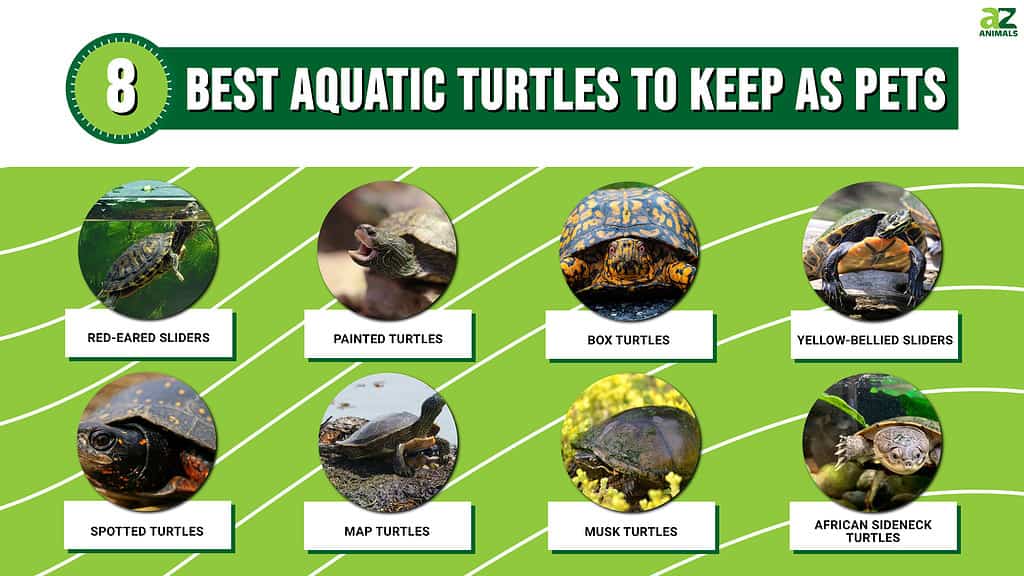
Aquatic turtles spend a lot of their lives in the water. Compared to other species, they need a lot more water in their environment. But they still need places to beach and bask. They tend to prefer warmer water and environments. Heat lamps and UVB lamps are essential parts of their environment, especially when kept indoors as a pet.
#1 Red-Eared Sliders
These fun turtles are great to keep in an aquarium tank, making them popular pets. They do require some special care and set up in their environment. They have characteristic red sections on their heads, giving them their name. These turtles start off small, often just a few inches long. They grow as they mature, however, and can get almost a foot long. As they grow, their tank size should also increase. Expect to need a 100-gallon tank by the time they are full-size adults.
Red-eared sliders can live for many years. So they are a commitment beyond just a few years. You might have your pet around for as long as 40 years! Even in the wild, these turtles live up to 20 years or longer. One of the things that make them so popular as pets is how easy to are to find. They don’t cost a lot like some pet species and are easy to breed, making them readily available for those looking for a pet turtle.
Feeding red-eared sliders is best done with a tool or by setting up their food in their tank. They eat both plants and animals, so make sure that you provide a varied diet to meet their nutritional needs. You’ll also need to provide a heat lamp and UVB lamp to keep their aquatic environment comfortable. Like with any pet aquatic turtle, maintaining their water quality is important to keep them happy and healthy.

Red-eared sliders need plenty of water in their environment to stay happy and healthy.
©iStock.com/slowmotiongli
#2 Painted Turtles
The striking markings on these turtles’ shells give them their name and make them interesting pets to watch. They can get up to 12 inches long as adults and females are almost always larger and longer than males. These turtles also live a long time, possibly up to 50 years! So before adding one of these pets to your family, make sure that you’re ready for the long-term commitment.
You’ll need a large tank for this species as well. Make sure it has plenty of water as well as places for the turtles to bask under a heat lamp. They’ll need food and water to drink as well. Some painted turtle owners create a beach with gravel and other large rocks that let the turtles lounge. A 100-gallon tank or even an indoor kiddie pool setup is ideal for these turtles. Just make sure that you are able to monitor the water quality to keep them healthy.
Painted turtles eat their food while swimming, which can mean a lot of cleaning and maintenance to keep the tank clean. Aquatic turtle pellets that float can help make this process easier while also providing them with the nutrition that they need. Leafy greens are also a necessary part of their diet. Insects like crickets, small things like shrimp, and even cut-up fruit make a nice occasional treat.
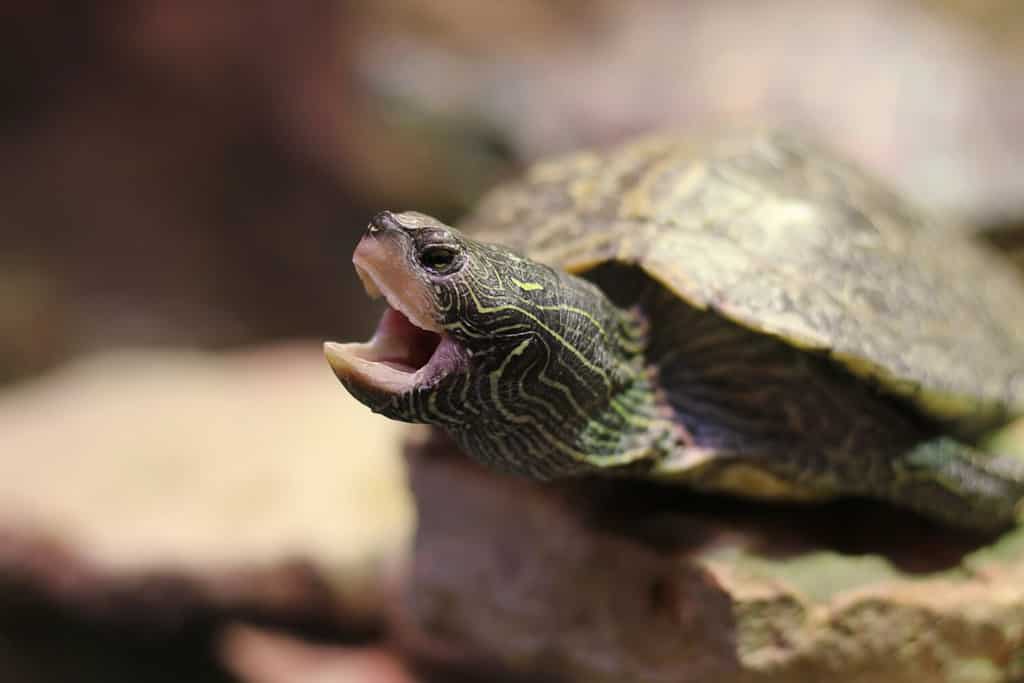
Painted turtles like a variety of food and are omnivores.
©Busiukas/Shutterstock.com
#3 Box Turtles
These turtles can be complex to care for and have very specific requirements. It can also be difficult to find a reputable place to buy a box turtle, although it is an important consideration in order to help with conservation efforts for the species as a whole. These aren’t great pets for newbies. But if you have some experience with turtles, caring for a box turtle can be extremely fun and rewarding.
They grow up to 7 inches long. This is a bit smaller than some other turtle species, meaning that their tank requirements aren’t as big. They more than makeup for it in cleaning and maintenance needs, however. Box turtles are extremely sensitive to stress. If the water or rocks or other parts of their tank get dirty, they are quick to let you know that they aren’t happy. This can result in health issues that take a long time to resolve. Giving the tank a weekly cleaning and monitoring for issues can help you stay on top of their care.
Box turtles really like access to the outdoors. If you live in a warm or mild climate, consider keeping your turtle outside year-round. Moving them outdoors for part of the year can help with their longevity, even if you need to bring them inside once temperatures drop. The difficult part of this is that box turtles also like consistency in their environment. So if you have to move them between habitats, try to replicate as many of the features as you can. They like a warm basking area, a substrate where they can burrow, and plenty of water for swimming. You should include a UVB lamp and a heat lamp.
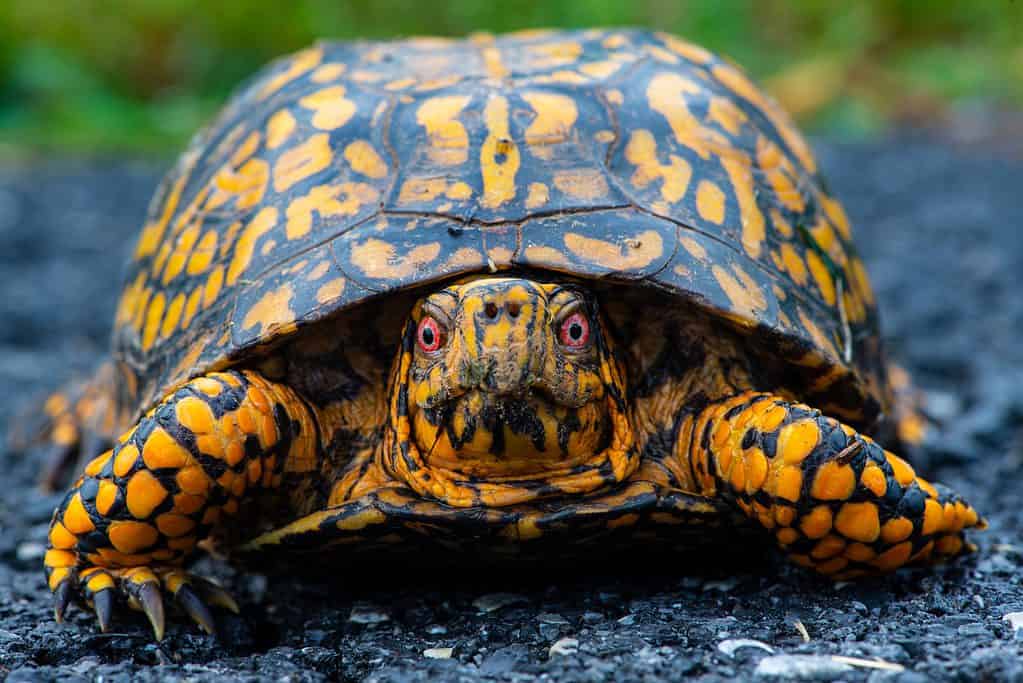
The box turtles of North America have dome-shaped shells which hinge at the bottom.
©RenEgAdeRooStEr/Shutterstock.com
#4 Yellow-Bellied Sliders
These turtles are related to red-eared sliders and share many of the same requirements when it comes to setting up their environment and caring for them. They have yellow bellies with black spots and yellow stripes on their shells. This interesting coloring makes them popular to keep for those looking for a pet aquatic turtle.
They spend a lot of their time basking in the warm sun in the wild. In a tank, you’ll need to replicate this with a heat lamp and UVB lamp. Turtles require exposure to UVB, which they use to process the calcium needed to maintain their shells. If they do not have UVB lamps available, they’ll have major health issues and may even die. Fortunately, these are easy to find anywhere that sells tanks for the care of aquatic turtles and other reptiles.
Females are generally larger than males and can get up to 13 inches long when fully grown. They’ll need large tanks of 100 gallons or more. When you first bring home a young yellow-bellied slider, you can have a smaller tank. But within a few years, you’ll need a large tank that provides them with enough space. Some pet owners opt for the larger setup from the beginning. This also reduces the change in the turtle’s life. They can be sensitive to changes as well as excessive handling, which causes stress.

Yellow-bellied sliders like to rest on the logs in the Rainbow River in Florida. This pond turtle has a brown or green shell with yellow on its underside.
©iStock.com/jrubacha
#5 Spotted Turtles
These little turtles are smaller than other popular aquatic turtle pets, making them a good choice for those who don’t have enough room to maintain a large tank. They grow up to 6 inches long and may even be a bit smaller. They have spots on their faces, necks, and shells. Like with most turtles, females tend to be a bit larger than males. One of the easiest ways to tell the difference between females and males is to look at the coloring on their chins. Females have red or brown chins, while males have black chins.
Spotted turtles often live to over 20 years and can even be as old as 50 years old! So before getting a spotted turtle, make sure that you’re ready for the commitment having one of these reptiles as a pet involves. Spotted turtles are omnivores but tend to enjoy more meat than some other turtle species. Crickets, shrimp, and other small insects are tasty for them. They do need veggies like leafy greens, although their preference for one or the other can vary by the turtle. Aquatic turtle pellets are another good option to help ensure they get all of the nutrients that they need.
While they are aquatic and need water in their environment, spotted turtles are not strong swimmers. They like shallow water and do best in water where they can touch the bottom. You should also provide plenty of areas for them to bask under a heat lamp. They’ll also need a UVB lamp to ensure proper shell development and health, like other species of turtles. Young spotted turtles spend more time in the water than their adult counterparts.
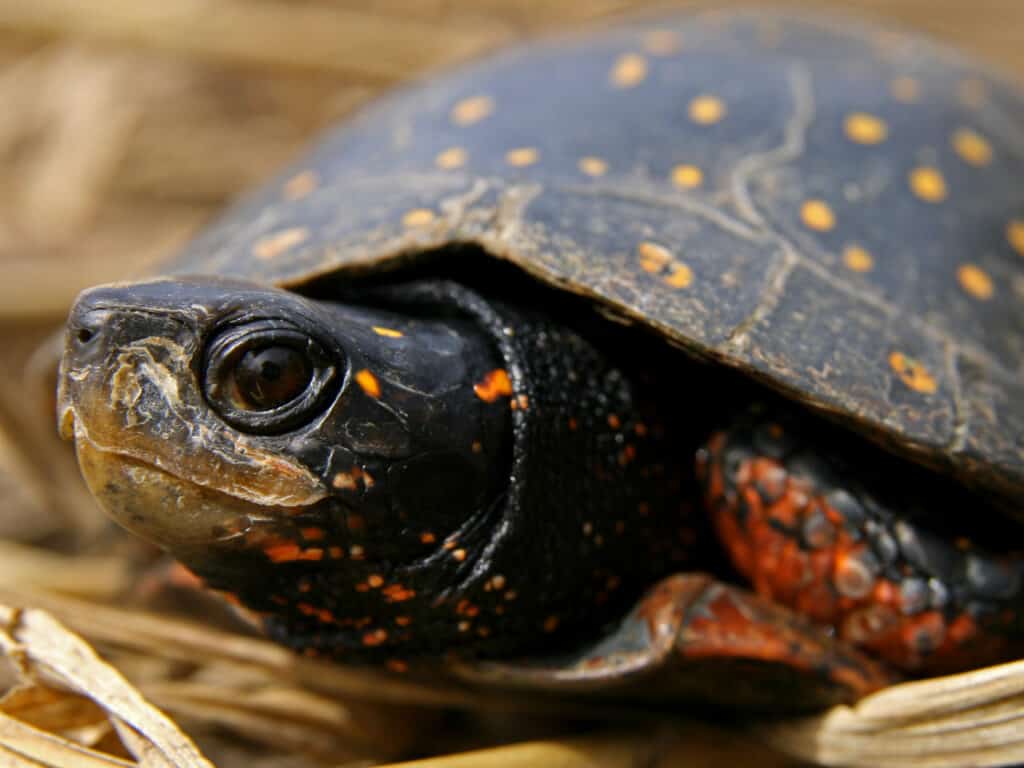
Spotted turtles are named for their spotted bodies and shells.
©Ryan M. Bolton/Shutterstock.com
#6 Map Turtles
There are many species of map turtles but one thing they all have in common is the raised aspects of their shell that look like the lines on a map.
These turtles need deep water in their environment. They tend to go to deeper water when they are feeling stressed to get a sense of safety and security. Without this space, they can experience a lot of stress that can cause far-reaching health problems. Stress often comes from too much handling, so it’s best to leave them alone unless it is absolutely necessary to handle them. Caring for these turtles involves cleaning and maintaining their habitat and providing access to clean food and water.
Female map turtles can get up to 10 inches long while males often top out around 5 inches. This is one reason that the females are so much more dominant than the males. You can keep male and female box turtles together but having two females in one tank should be avoided.
You’ll need a large tank, especially if you have multiple turtles. Females need 125-gallon tanks or larger, while males can be happy in something a bit smaller, around 100-gallons. They like to swim and will need deep water in the tank. As reptiles, they still need a place to stay warm and bask under a heat lamp and UVB lamp, however. Some owners found that creating a rocky area on one side of the tank was ideal. A filter helps keep the water clean as well as circulates water through the environment. They tend to like this as it mimics the current that they are used to in the wild. You can even add a powerhead to generate an artificial current.
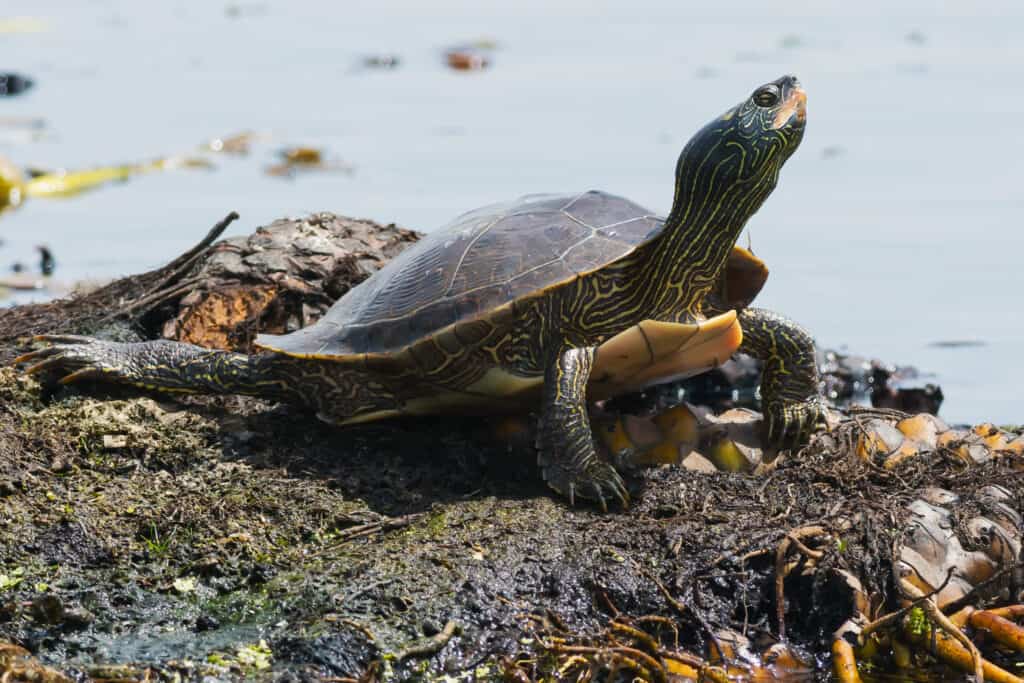
The northern map turtle is endemic to North America.
©iStock.com/PaulReevesPhotography
#7 Musk Turtles
These turtles are a bit smaller, often growing up to 4 to 5 inches as adults. They have two distinctive yellow stripes on the top of their head and neck. They don’t need quite as large of a tank as some other turtles but should still have plenty of space for water, basking, and eating and drinking.
They eat small insects and crustaceans, such as some types of worms, crickets, and shrimp. These turtles also need fresh vegetables with leafy greens being the easiest and most popular options. Aquatic turtle pellets round out their diet to make sure that they get the right balance of nutrients.
Like with other turtle species, tank maintenance is very important. They have to have clean water that is the right temperature. A basking area is also important since they need to be able to regulate their body temperature by lying under a heat lamp. A UVB lamp is essential for shell health. Without it, they can’t metabolize calcium in their diets and will have issues maintaining their hard shells.

The common musk turtle is also known as the eastern musk turtle or stinkpot turtle due to its ability to release a foul musky odor from scent glands on the edge of its shell.
©Ontley, CC BY-SA 3.0 – License
#8 African Sideneck Turtles
These are some of the most unique-looking aquatic turtles, making them a great choice for those who want a pet that is a bit unexpected in the looks department. They have long necks that make their heads appear to extend quite far beyond their shells. Instead of retracting their heads into their shells like other turtles, these pets tuck their heads to the side. They can be a bit pricier than more common species and harder to find. But it’s important to do your research and find a reputable dealer to buy your turtle from.
Their shells are also flat compared to other species. They tend to be brown or black. They grow around 6 to 10 inches as adults and require tanks that are 55 gallons or larger. Like other aquatic turtles, make sure that there is plenty of water, a place to bask under a heat lamp, a filtration system to keep the water clean, access to food and water, and a UVB lamp. They tend to be lower maintenance than some other species but it is still important to maintain their habitats.
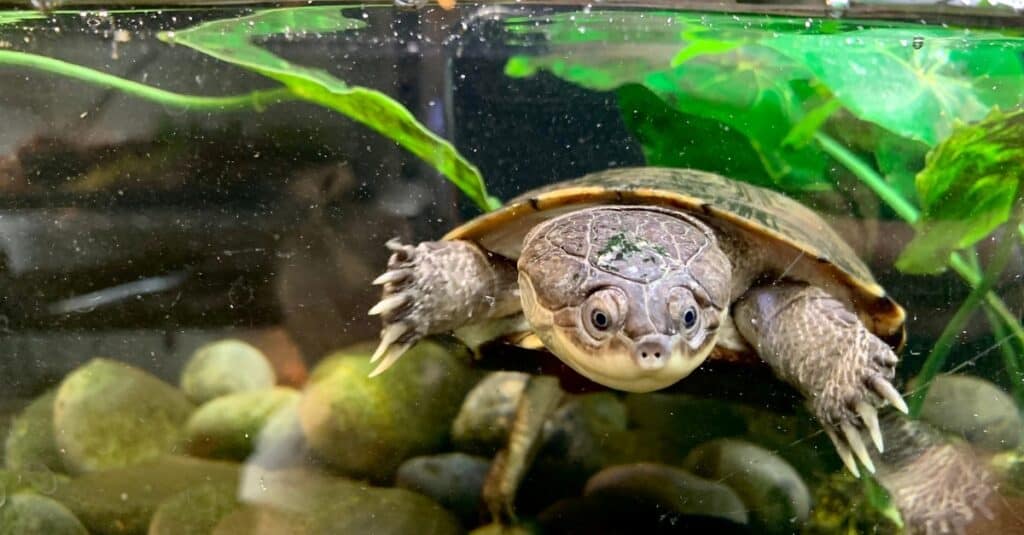
African side neck turtle swimming in a stream. The neck of these pond turtles is longer than most other types of turtles.
©Megan Czarnocki/Shutterstock.com
Summary of the Best Aquatic Turtles to Keep as Pets
| Number | Species | Size |
| 1 | Red-Eared Sliders | 5-11 inches |
| 2 | Painted Turtles | 2.5-10 inches |
| 3 | Box Turtles | 5-7 inches |
| 4 | Yellow-Bellied Sliders | 5-13 inches |
| 5 | Spotted Turtles | 4-6 inches |
| 6 | Map Turtles | 5-10 inches |
| 7 | Musk Turtles | 4-5 inches |
| 8 | African Sideneck Turtles | 6-10 inches |
The photo featured at the top of this post is © xbrchx/Shutterstock.com
Thank you for reading! Have some feedback for us? Contact the AZ Animals editorial team.






